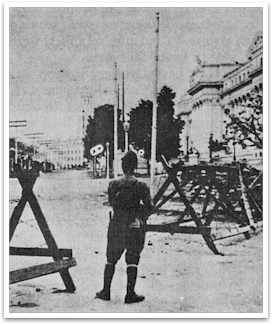The Means of Defense
Tactically, Iwabuchi's defensive preparations left much
to be desired. One line of defensive positions, while usually (but not
always) containing mutually supporting strongpoints, did not necessarily
give way to a second line of prepared positions; seldom were any two lines
mutually supporting. Little provision seems to have been made for routes of
withdrawal from one line to another. The core of the defenses, if any
existed, was Intramuros, the approaches to which were protected by a
semicircle of fortified government buildings and schools extending from the
General Post Office, on the south bank of the Pasig about three blocks off
the northeast corner of Intramuros, around to the Army-Navy Club, on the bay
front a few hundred yards south of the walled city,
A prime characteristic of the defenses within the city
was improvisation based upon the ready, man-made defenses of heavily
reinforced concrete buildings. The Japanese fortified building entrances
with sandbags; they set up barricades along corridors and stairways; they
chopped firing slits for rifles and machine guns through outside walls; they
dug tunnels that connected the basements of various buildings or led to
outside pillboxes and bunkers. While the defenders constructed many bunkers
and pillboxes throughout the city, they depended principally on the
buildings, and most of the standard military defensive installations were
located in the Southern
Force's area of
responsibility.
The Manila
Naval Defense Force barricaded
streets and intersections throughout the city with all types of obstacles:
barbed-wire entanglements; oil drums filled with dirt or cement; rails set
into the pavement; hastily dug ditches; trolley cars, trucks, and
automobiles; even heavy factory machinery wrenched from interior mountings.
The defenders employed mines of every conceivable type and improvisation,
including Japanese Navy beach mines and depth charges, artillery shells,
aerial bombs, mortar shells, and standard Japanese Army antipersonnel and
antitank mines. Most mine fields were poorly camouflaged and although the
Japanese covered some with fire from prepared positions, they had
established no pattern that tied one mine field into another or related a
field to major defenses.
Another outstanding characteristic of the Japanese
defense preparations was the great number of automatic weapons, a number all
out of proportion to the troop strength. The basic infantry weapon, the
rifle, played a very secondary role, being used mainly for the protection of
the automatic weapons and for last-ditch personnel defense. The much
publicized--but seldom encountered--Japanese sniper played no significant
part. Indeed, after the battle XIV Corps reported:
Despite frequent mention by our troops of "snipers,"
the sniper as a carefully placed individual rifleman specializing in
long-range selective firing seldom made an appearance (hardly any
telescopic rifle sights were found in Manila).14
On the other
hand, the Japanese used various types of grenades with great abandon,
especially in defense of buildings.
In preparing for extensive employment of automatic
weapons, the Manila Naval
Defense Force had removed
many such arms from ships sunk in the bay and from aircraft lying destroyed
or damaged on the numerous outlying airfields.15 Ordnance
troops adapted these for ground use, and also set up for employment against
ground targets many of the antiaircraft weapons with which Manila and
environs bristled before the Allies entered the city. The principal
automatic weapons upon which the defenders set great store were the aircraft
and antiaircraft 20-mm. and 25-mm. machine cannon. They had also a few
40-mm. antiaircraft weapons, as well as innumerable infantry and
antiaircraft machine guns of lesser caliber. Mortars played a large part in
the defense; literally hundreds of these weapons, varying from 50-mm. to
150-mm in caliber, were available to Iwabuchi's men.
The basic heavy artillery weapon was the Japanese Navy's
dual-purpose 120-mm. gun. The Manila
Naval Defense Force emplaced
over fifty of these weapons in and around the city, most of them in the
Nichols Field-Fort McKinley area. In addition, the Japanese had some
76.2-mm. dual-purpose guns, a few Army 75-mm. antiaircraft weapons adapted
for ground fire, a scattering of 75-mm. Army field artillery pieces, and
some Army 47-mm. antitank guns. Finally, for the first time during the war
in the Pacific, the Japanese employed rockets to an appreciable extent. Most
of those available to the Manila
Naval Defensive Force were
200-mm. Navy rockets, but the force also possessed some 200-mm. Army rockets
and a few Navy 450-mm. giants.
Practically none of Iwabuchi's troops had any unit
training in ground combat operations and many had very little individual
infantry training. The proficiency of men assigned to crew-served weapons
usually left much to be desired. Perhaps the best units were the Army
provisional infantry battalions, many members of which were infantry or
other ground force replacements stranded in Manila. But few of these men
were first line, and the vast majority of even the Army personnel were
members of the service branches.
Naval units were in even worse state. The only troops
among them having any semblance of ground combat training were the few
members of the ground defense sections of the 31st
Naval Special Base Force. For
the rest, the naval troops were aircraft maintenance men, airfield
engineers, crews from ships sunk in the bay, casuals, other service
personnel of all types, and even some Japanese civilians pressed into
uniform.
Admiral Iwabuchi had time neither to train his troops nor
to complete defensive preparations. Even so, his defenses were strong and,
although held by inferior troops, could prove formidable when manned by men
with little thought of escape. He defended Manila with what he had, and what
he had was sufficient to cause XIV Corps great trouble.
|


